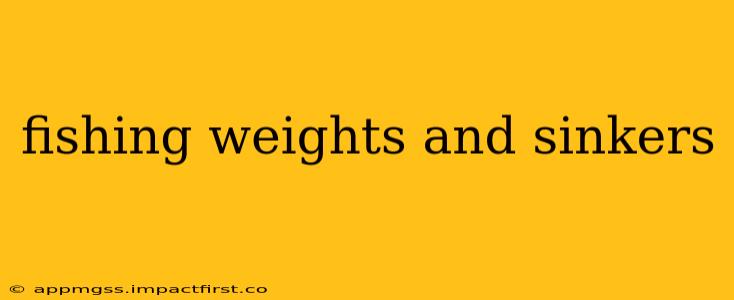Fishing weights, also known as sinkers, are crucial for many fishing techniques. They help get your bait or lure down to the desired depth, keep your line tight, and even aid in casting distance. Understanding the different types of fishing weights and when to use them is key to successful fishing. This comprehensive guide will explore the various types, their applications, and how to choose the right one for your needs.
What are Fishing Weights Used For?
Fishing weights serve several important functions:
-
Getting to the Depth: The primary function is to get your bait or lure to the correct depth in the water column. This is especially important when fishing in deeper water or targeting fish that hold at specific depths.
-
Casting Distance: Heavier weights improve casting distance, allowing you to reach further into the water. This is particularly beneficial when fishing from a boat or shore, where you need to cover more ground.
-
Line Control: Weights help keep your line taut, giving you better feel of your bait or lure and allowing for quicker hooksets. A tight line is vital for detecting subtle bites.
-
Bait Presentation: Certain weights, like split shot, allow for precise bait placement and presentation, ideal for subtle presentations near cover.
-
Counteracting Current: In rivers or streams with strong currents, weights are necessary to keep your bait or lure from being swept away before reaching the target fish.
Different Types of Fishing Weights and Sinkers
There's a wide variety of fishing weights available, each designed for specific applications:
1. Lead Sinkers:
Historically the most common, lead sinkers are dense and effective. However, concerns about lead's toxicity to the environment have led many anglers to seek alternatives.
- Round: These are versatile and work well for most fishing situations.
- Pear: The aerodynamic shape helps with casting distance and is excellent for bottom fishing.
- Dipsey: Used primarily in trolling, these sinkers allow for precise depth control.
- Egg: Similar to round sinkers but slightly more streamlined.
2. Tungsten Sinkers:
Tungsten is significantly denser than lead, making it possible to use smaller, more streamlined weights to achieve the same depth and casting distance. This is advantageous for finesse fishing and situations where a less bulky weight is preferred.
- Round: Offers excellent versatility and casting ability.
- Drop Shot: Designed for specific drop shot fishing techniques.
- Bullet: Streamlined shape for long casts and minimal resistance.
3. Steel Sinkers:
Steel sinkers are durable and corrosion-resistant, making them a long-lasting option, although they can be less effective in casting distance than tungsten.
4. Split Shot:
Small, pinched-on weights ideal for light tackle fishing and precise bait placement.
5. Bank Sinkers:
These weights are designed for fishing from the bank, often featuring a clip or loop to easily attach and detach the line.
Choosing the Right Fishing Weight
Selecting the appropriate weight depends on several factors:
- Depth: Deeper water requires heavier weights.
- Current: Strong currents necessitate heavier weights to keep your bait in place.
- Bait/Lure: Lighter baits/lures require less weight.
- Fishing Technique: Different techniques (e.g., bottom fishing, trolling, drop shot) call for different weight types and sizes.
- Line Type & Strength: Your line's strength and type should be considered to avoid breaking your line.
How to Attach Fishing Weights
The method of attaching weights varies depending on the type of sinker and fishing technique:
- Swivels: Using swivels prevents line twist.
- Clips: Quick release clips facilitate quick changes of weight.
- Directly to the Line: Some sinkers are designed to be directly attached to the fishing line.
What are the different types of fishing weights?
This question is answered extensively in the "Different Types of Fishing Weights and Sinkers" section above. It covers lead, tungsten, steel, split shot, and bank sinkers, providing detail on each type.
How do I choose the right fishing weight for my needs?
The "Choosing the Right Fishing Weight" section provides a detailed explanation, considering factors like depth, current, bait/lure size, fishing technique, and line type and strength.
What are the best fishing weights for beginners?
For beginners, starting with round lead or tungsten sinkers in a variety of weights is recommended. These are versatile and easy to use. Split shot is also a good option for learning precise bait placement. Avoid overly complex weight systems until you gain experience.
Are lead fishing weights safe for the environment?
Lead is toxic to the environment and many anglers are switching to alternatives like tungsten or steel sinkers to reduce environmental impact.
This comprehensive guide provides a strong foundation for understanding and utilizing fishing weights effectively. Remember to always prioritize responsible fishing practices and consider the environmental impact of your choices.
